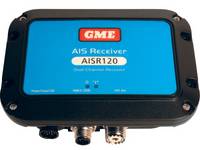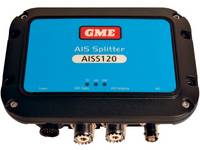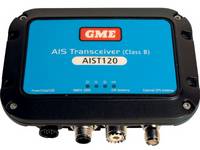Gme, Ais
-
AISR120 AIS receiver
Dual channel receiverFor boaters requiring an AIS message receiver only, GME offers the dual channel AISR120; incorporating two ultra sensitive receivers coupled to a sophisticated processor with RMax!22 technology. Ideally suited for installation on leisure boats where collision avoidance is the primary concern, the AISR120 can be interfaced to a PC, notebook, or GME chartplotter for greater situational awareness.The AISR120 will receive both static and dynamic information from both AIS class A and B equipped vessels, aids to navigation and base stations that are within VHF range. The AISR120 can use either a dedicated AIS antenna, or share the vessel 19s existing VHF antenna via the AISS120 VHF antenna splitter.One of the most important safety features and fastest growth areas in marine Navigation is AIS - Automatic Identification System. This collision avoidance technology is particularly valuable to boaters who regularly travel or fish in busy waterways or near major shipping routes. Having an operating AIS transponder onboard will turn your boat into a visible radio beacon indicating your speed, course and identity to other AIS equipped vessels or base stations.An AIS receiver will allow you to track other AIS traffic in the area and identify 18Aids to Navigation 19 (AtoN) even when not visibly by sight. You 19ll no longer be inhibited by limitations like 18inline-of-site 19 radar. Unlike radar, AIS allows you to 18see 19 other AIS equipped craft behind obstructions like islands and land masses or hidden behind another vessel, and is equally effective in fog or darkness. AIS information is displayed on dedicated AIS screens or AIS compatible Chartplotters.AIS ReceiversAIS receivers collect the transmissions from AIS transceivers, base stations and aids to navigation displaying them on compatible chartplotters or dedicated displays. An AIS receiver does not transmit information about your vessel and is used to provide you with situational awareness of other traffic and hazards in the area.
-
AISS120 Antenna Splitter
Zero loss active VHF antenna splitterVHF radios and AIS devices operate within the same frequency band and as such can use the same VHF antenna. The AISS120 Active Antenna Splitter permits a standard marine VHF antenna to serve both the AIS device and VHF radio without any degradation of signal. Using advanced signal processing the AISS120 is the perfect solution for AIS installations on boats where additional antenna mounting space is not available. Clear Call Routing provides a key safety feature, ensuring VHF radio emergency priority and full operational performance even when power fails.The AISS120 AIS antenna splitter is designed to work primarily with class B AIS transceivers such as the AIST120, although it will operate equally well with AIS receivers such as the AISR120.The AISS120 is supplied with the necessary cables to connect to a VHF radio and either the AIST120 or AISR120One of the most important safety features and fastest growth areas in marine Navigation is AIS - Automatic Identification System. This collision avoidance technology is particularly valuable to boaters who regularly travel or fish in busy waterways or near major shipping routes. Having an operating AIS transponder onboard will turn your boat into a visible radio beacon indicating your speed, course and identity to other AIS equipped vessels or base stations.An AIS receiver will allow you to track other AIS traffic in the area and identify 18Aids to Navigation 19 (AtoN) even when not visibly by sight. You 19ll no longer be inhibited by limitations like 18inline-of-site 19 radar. Unlike radar, AIS allows you to 18see 19 other AIS equipped craft behind obstructions like islands and land masses or hidden behind another vessel, and is equally effective in fog or darkness. AIS information is displayed on dedicated AIS screens or AIS compatible Chartplotters.
-
AIST120 AIS Transceiver
AIS transmitter/receiver with internal GPS antennaThe AIST120 can be considered as a vessel 19s electronic beacon. By regularly broadcasting critical static and dynamic information to all similarly equipped vessels within range, the AIST120 provides boat owners with a vital navigation tool, particularly when operating at night or under poor visibility conditions.Transmitted data includes vessel name, length, registration, plus speed over the ground (SOG), course over the ground (COG), as well as location coordinates which are automatically calculated and updated by the AIST120 19s integrated 50 channel GPS receiver.The AIST120 through its ultra sensitive dual channel Rmax!22 technology will receive and decode transmitted AIS data from other vessels, AtoNs and base stations within VHF range; this information can be displayed on a compatible chart plotter, radar or PC charting system.Received AIS information positively identifies any commercial vessel within range, it also provides its radio call sign, heading, closest point of approach (CPA) and time to CPA. Using this information leisure craft can make a VHF radio call to the vessel in question to verify its intended course and avoid collision.Through the application cutting edge TDMA technology the AIST120 is compatible and inter-operable with both Class A and B AIS systems through the VHF radio data link.An internal GPS antenna makes for easy installation; however the AIST120 has provision for an external GPS antenna input for installations requiring the use of an optional external GPS antenna. (GPS450).The GME AIST120 has dual NMEA0183 and NMEA2000 interfaces for simplistic connection to stand alone chart plotters or integration into more sophisticated on-board communication networks. 22 Maritime Mobile Service Identity (MMSI) 22 Vessel name 22 Vessel call sign (if available) 22 Vessel type 22 Vessel dimensionsThe AIST120 has the option for a toggle switch (not supplied) to be connected, offering a silent mode. No vessel information will be transmitted when silent mode is active.The AIS transceiver works in an autonomous and continuous mode, regardless of whether it is operating in the open seas, coastal or inland areas. Transmissions frequency is between 156.025 13162.025 MHz. Received data is on either 161.975 MHz or 162.025 MHz.There are two categories of information transmitted by an AIS transceiver: 18static data 19 and 18dynamic data 19. The vessel 19s dynamic data, which includes location, speed over ground (SOG) and course over ground (COG), is calculated automatically using the internal GPS receiver. An optional external GPS can be connected (GPS450) to the AIST120, an AD408 adaptor is also required. Static data is information about the vessel which must be programmed into the AIS transceiver. Software is included to enable the AIST120 to be programmed with ship 19s data.


